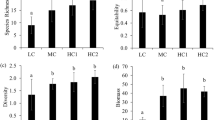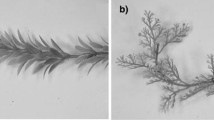Abstract
We tested the hypothesis that structural complexity is an important factor influencing the abundance and taxon richness of microfauna (e.g., rotifers, copepods, cladocerans) in littoral habitats. Research on littoral microfauna has to date focused mainly on field observations, which commonly show microfauna have preference for some macrophytes over others. However, while such studies commonly conclude that macrophyte architecture is a major determinant of these variations, independent factors may also be responsible (e.g., differences in macrophyte ages, differences in macrophyte bed densities and the depth of the respective macrophyte beds sampled). We used artificial macrophytes with three levels of complexity to keep the surface area and mass of the substrate sampled constant, and to control for confounding factors not related to the complexity of the plants. Our results support the hypothesis that structural complexity is an important factor influencing abundance and taxon richness, independent of other potential confounding factors. Microfaunal (mainly rotifer) abundance and richness were generally greater on more complex artificial macrophytes, likely a result of more complex substrates (1) providing a greater variety of habitat, (2) supporting a greater concentration or variety of food and/or (3) affording greater protection against predators. Less mobile surface-associated (i.e., benthic/periphytic) taxa were found to discriminate among substrates, whereas the abundance and richness of planktonic species were not affected by complexity level. Relatively low abundances and taxon richness of microfauna recorded in control samples, which did not contain artificial macrophytes, supports the contention that vegetated areas sustain a higher abundance and variety of species than non-vegetated areas.



Similar content being viewed by others
References
Chapman MA, Lewis MH (1976) An introduction to the freshwater Crustacea of New Zealand. William Collins (New Zealand) Ltd, Auckland
Cheruvelil KS, Soranno PA, Serbin RD (2000) Macroinvertebrabes associated with submerged macrophytes: sample size and power to detect effects. Hydrobiologia 441:133–139
Cyr H, Downing JA (1988) The abundance of phytophilous invertebrates on different species of submerged macrophytes. Freshwater Biol 20:365–374
Declerck SD, Anderstukken MV, Als AP, Uylaert KM (2007) Plankton biodiversity along a gradient of productivity and its mediation by macrophytes. Ecology 88:2199–2210
Dudley TL (1988) The roles of plant complexity and epiphyton in colonization of macrophytes by stream insects. Verh Internat Verein Theor Angew Limnol 23:1153–1158
Duggan IC (2001) The ecology of periphytic rotifers. Hydrobiologia 446(447):139–148
Duggan IC, Green JD, Thompson K, Shiel RJ (1998) Rotifers in relation to littoral ecotone structure in Lake Rotomanuka, North Island, New Zealand. Hydrobiologia 387(388):179–197
Duggan IC, Green JD, Thompson K, Shiel RJ (2001) The influence of macrophytes on the spatial distribution of littoral rotifers. Freshwater Biol 46:777–786
Gerrish N, Bristow JM (1979) Macroinvertebrate associations with aquatic macrophytes and artificial substrates. J Great Lakes Res 5:69–72
Gotelli NJ, Colwell RK (2001) Quantifying biodiversity: procedures and pitfalls in the measurement and comparison of species richness. Ecol Lett 4:379–391
Grimshaw HJ, Wetzel RG, Brandenburg M, Segerblom K, Wenkert LJ, Marsh GA, Charnetzky W, Haky JE, Carraher C (1997) Shading of periphyton communities by wetland emergent macrophytes: decoupling of algal photosynthesis from microbial nutrient retention. Arch Hydrobiol 139:17–27
Hansen JP, Sagerman J, Wikstrom SA (2010) Effects of plant morphology on small-scale distribution of invertebrates. Mar Biol 157:2143–2155
Hicks BJ, Bryant N (2002) Management of the University of Waikato campus lakes: final report. CBER contract report 23, Centre for Biodiversity and Ecology Research, Department of Biological Sciences, School of Science and Technology, The University of Waikato, Hamilton, New Zealand
Jeffries M (1993) Invertebrate colonisation of artificial pondweeds of differing fractal dimension. Oikos 67:142–148
Jones JI, Young JO, Haynes GM, Moss B, Eaton JW, Hardwick KJ (1999) Do submerged aquatic plants influence their periphyton to enhance the growth and reproduction of invertebrate mutualists? Oecologia 120:463–474
Koste W (1978) Rotatoria. Die Radertiere Mitteleuropas, vol 2. Gebrüder Borntraeger, Stuttgart
Kuczyńska-Kippen N (2006) Zooplankton structure in architecturally differentiated macrophyte habitats of shallow lakes in the Wielkopolska Region, Poland. Oceanol Hydrobiol Stud 35:179–191
Kuczyńska-Kippen N (2008) Spatio-temporal segregation of cladocerans within a Chara hispida bed. J Freshwat Ecol 24:533–539
Kuczyńska-Kippen N, Milecka E (2009) The diurnal distribution of the zooplankton community of the littoral zone of Lake Wielkowiejskie (Wielkopolski National Park, Poland). Oceanol Hydrobiol Stud 38:91–98
Kuczyńska-Kippen N, Nagengast B (2003) The impact of the architecture of macrophytes on the spatial structure of zooplankton. Roczniki Akademii Rolniczej w Poznaniu 154:121–129
McAbendroth L, Foggo A, Rundle SD, Bilton DT (2005) Unravelling nestedness and spatial pattern in pond assemblages. J Anim Ecol 74:41–49
McCormick PV, Pratt JR, Jenkins DG, Cairns J Jr (1988) A comparison of protozoan, algal, and metazoan colonization of artificial substrates of differing size. Trans Am Microsc Soc 107:259–268
Parsons TR, Marita Y, Lalli CM (1984) A manual of chemical and biological methods for sea water analysis. Pergamon Press, Oxford
Pejler B (1962) On the taxonomy and ecology of benthic and periphytic Rotatoria. Investigations in northern Swedish Lapland. Zoologiska Bidrag Från Uppsala 33:327–422
Pontin RM, Shiel RJ (1995) Periphytic rotifer communities of an Australian seasonal floodplain pool. Hydrobiologia 313(314):63–67
Preissler K (1980) Field experiments on the optical orientation of pelagic rotifers. Hydrobiologia 73:199–203
Rooke JB (1984) The invertebrate fauna of four macrophytes in a lotic system. Freshwater Biol 14:507–513
Rooke JB (1986) Macroinvertebrates associated with macrophytes and plastic imitations in the Eramosa River, Ontario, Canada. Arch Hydrobiol 106:307–325
Schriver P, Bogestrand J, Jeppensen E, Sondergaard M (1995) Impact of submerged macrophytes on fish-zooplankton-phytoplankton interactions: large-scale enclosure experiments in a shallow eutrophic lake. Freshwater Biol 33:255–270
Shiel RJ (1995) A guide to the identification of rotifers, cladocerans and copepods from Australian inland waters. Co-operative Research Centre for Freshwater Ecology, Murray-Darling Freshwater Research Centre. Albury, New South Wales
Taniguchi H, Takano S, Tokeshi M (2003) Influences of habitat complexity on the diversity and abundance of epiphytic invertebrates on plants. Freshwater Biol 48:718–728
Tessier C, Cattaneo A, Pinel-Alloul B, Galanti G (2004) Biomass, composition and size structure of invertebrate communities associated to different types of aquatic vegetation during summer in Lago di Canada (Italy). J Limnol 63:190–198
Thomaz SM, Dibble ED, Evangelista LR, Higuti J, Bini LM (2008) Influence of aquatic macrophyte habitat complexity on invertebrate abundance and richness in tropical lagoons. Freshwater Biol 53:358–367
van Donk E, van de Bund WJ (2002) Impact of submerged macrophytes including charophytes on phyto- and zooplankton communities: allelopathy versus other mechanisms. Aquat Bot 72:261–274
Vieira LCG, Bini LM, Velho LFM, Mazao GR (2007) Influence of spatial complexity on the density and diversity of periphytic rotifers, microcrustaceans and testate amoebae. Fund Appl Limnol 179:77–85
Wallace RL, Edmondson WT (1986) Mechanism and adaptive significance of substrate selection by a sessile rotifer. Ecology 67:314–323
Walsh EJ (1995) Habitat-specific predation susceptibilities of a littoral rotifer to two invertebrate predators. Hydrobiologia 313(314):205–211
Willis K (1996) The University of Waikato Campus Lakes. Water quality status monitoring December 1995 to May 1996. University of Waikato technical report, p 20
Acknowledgments
We thank members of CBER for discussion that improved our experimental design, and especially Dai Morgan for his ideas and for the use of his experimental platforms. P. Lucena-Moya was supported by a grant from the University of Vigo.
Author information
Authors and Affiliations
Corresponding author
Additional information
Handling Editor: Dr. Piet Spaak.
Rights and permissions
About this article
Cite this article
Lucena-Moya, P., Duggan, I.C. Macrophyte architecture affects the abundance and diversity of littoral microfauna. Aquat Ecol 45, 279–287 (2011). https://doi.org/10.1007/s10452-011-9353-0
Received:
Accepted:
Published:
Issue Date:
DOI: https://doi.org/10.1007/s10452-011-9353-0




